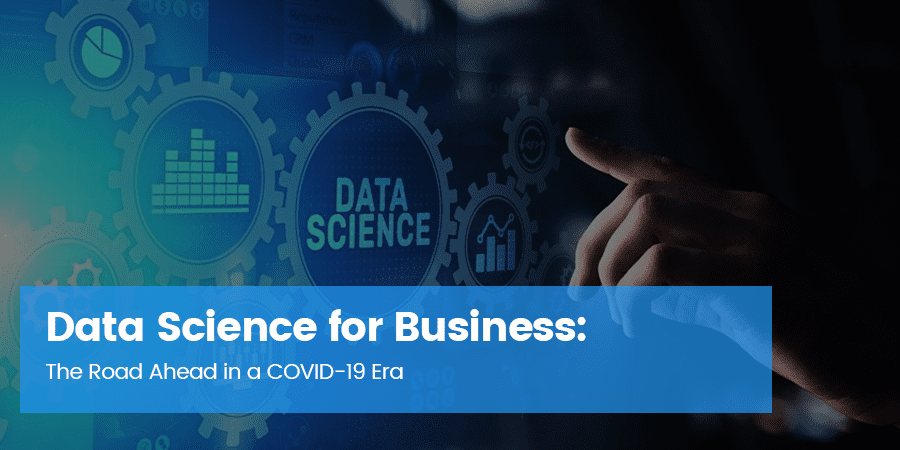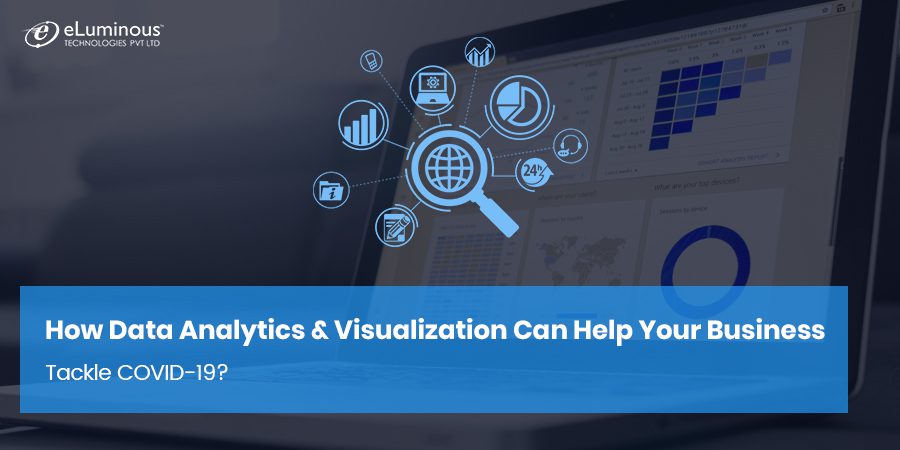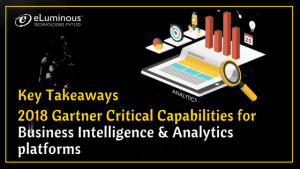Like with most technology areas, data science too was affected by the COVID-19 pandemic. However, while a lot of businesses curtailed their AI-driven data science expenditure to rationalize costs during the pandemic, the public sector comprising governments and public interest initiatives led by private firms doubled down on data science to fight the pandemic.
And though many factors that influence the market and economic environment are still evolving, there’s optimism that data science will regain its mojo in the commercial sector sooner rather than later. But this recovery will have its fair share of challenges too.
In this blog post, we look at the impact of COVID-19 and the economic slowdown on data science, five areas where data science will see an uptick, and what can businesses gain by investing in a data science solution.
Impact of COVID-19 on Data Science
While the vehicle that is data science did encounter minor potholes now and then, COVID-19 was nothing less than a massive trench on the road. A McKinsey report states that pandemic-induced consumer behaviour such as reduced face-to-face interaction, sparser public gathering, and lower spending has disrupted historical analytical models to a degree where pre-COVID data cannot be used to measure future business progress without certain adjustments.
Compounding this issue is the freshness of the post-outbreak data, making it insufficient to form a base of prediction for now. Moreover, it doesn’t help that this data is influenced by factors that are more or less tied to pandemic’s rise and eventual decline.
These include government-led fiscal intervention to keep consumption going, supply chain interruptions because of containment measures and disrupted consumption, change in consumer behaviour due to economic uncertainty, and the halo effect of the near-destruction of industries such as airline and hospitality.
Effect of Economic Recession on Data Science
As per the World Bank, the global economy is poised to shrink by 5.2% in 2020. What makes this downturn different from others of the recent past is that it’s likely to last longer.
The data science sector isn’t immune to these factors, as evident from the spate of lay-offs across companies. Even before the pandemic, the sector was experiencing a slight downturn.
The combined effect of this means that, besides publicly-funded data science initiatives, the sector as a whole might turn towards proven implementations such as data analytics and business intelligence.
A Decade of Data Analytics Growth
While corporate expenditure on data science suffered in the period leading up to and during the outbreak, tech behemoths like Google, Microsoft, and Amazon continued to hire dedicated developers to expand their analytics efforts, mainly centered around computer vision and NLP (Natural Language Processing).
Furthermore, businesses will look towards consolidation and rationalization in response to the recession. AI and machine learning systems are well-placed to play a vital role in this move as organizations search for more efficient and frugal ways to serve their customers.
Analytics and forecasting systems, as such, are likely to remain the main pipeline of data science expenditure in the coming decade. As this industry report shows, the healthcare vertical propelled by the COVID-19 exigency will lead the growth charts for the global analytics market in 2021.
Also read: Business in Covid Times: 8 Ways IT Makes It Business as Usual
Five Areas Where Data Science Will See an Uptick
1) Supply Chain and Logistics
Supply chain and logistics companies can use AI-enabled tools such as FranchisorPal to model historical as well as ‘live’ data to simulate several scenarios while factoring in situations such as local and national movement restrictions due to COVID-19.
Read more: FranchisorPal: Why It’s the Perfect Pal for Franchise Businesses (Case Study)
2) Remote Workforce Management
Thanks to the rise in remote working, organizations are investing in new ways to not just enhance workforce productivity but also monitor it using innovative metrics designed for a COVID-19 world.
For instance, PwC offered its staff the option to wear AI-enabled fitness bands to monitor their level of stress while working remotely due to the pandemic. There have also been instances of AI and ML being used to evaluate students who were forced into online learning environments due to the pandemic.
3) AI Chatbots
By providing official COVID-19 information, chatbots have served an important function for an overburdened health services sector. This has also helped improve the general public perception of AI-based assistants, which was otherwise a hindrance towards greater chatbot adoption for many businesses.
4) Real Estate
With the emergence of telecommuting, the real estate market has come under a lot of strain. But as rentals and buying slowly get back to their pre-pandemic momentum, there will be obstacles in the form of in-person visitation and property management.
This is a situation ripe for AI and machine learning, technologies that were already used to generate leads, assess mortgage lending risk, manage budgets, calculate property value, and conveyancing. In keeping COVID-19’s realities, these technologies can be used for virtual visitation and AR (augmented reality) applications.
5) Healthcare
As an industry pushed to the limits by COVID-19, healthcare is likely to accelerate its pre-pandemic move towards AI-enabled personalized health services. This will not only help patients avail of treatments faster and at lower cost, but also enable healthcare organizations to rationalize their staff’s workload.
Read more: How Machine Learning Helps with Healthcare and the Fight Against COVID-19?
Business Benefits of Investing in Data Science in a COVID-19 World
The disruption caused by the pandemic notwithstanding, businesses stand to gain a lot if they hire dedicated developers to build a robust data science solution. They’re likely to see good results once the post-outbreak datasets gain in volume and maturity.
1) Forecasting and Risk Mitigation
An important post-COVID lesson for businesses is that disruptions can spring out of the blue. Data science solutions are the most reliable way to predict such critical incidents, analyse risk, and develop mitigation strategies.
And unlike the pre-pandemic historical data, data gathered post the outbreak can make data science systems more reliable when it comes to predicting similar future obstacles.
2) Resource Assessment and Allocation
While forecasting offers a way for businesses to predict disruptions, resource assessment and deployment helps them deal with a disruption effectively. An analytics system can be used to solve critical business problems and gather relevant data.
For instance, an analytics team in sales can help your business prepare for disruptions resulting from upheavals in the economy. By helping you assess and allocate resources, analytics can facilitate agile decision-making during crises.
3) Identifying Opportunities
A robust data science solution can ensure business continuity by helping you identify the right opportunities. Analysing existing data and the gaps therein can help businesses spot new opportunities.
For instance, several companies aggregated their employee data with COVID case data to develop ways to better support their employees during a crisis. A good example is a dashboard that combines geographical data with COVID case data to inform employees about office closures and other prevention measures. This data can then be used to create a safe office reopening strategy.
4) Data Security and Protection
Cybersecurity, which was already a challenge for companies, became an even bigger one after the outbreak as most employees resorted to remote work. The accompanying rise in the use of cloud services further made it important to keep a check on maintenance and recovery.
AI- and ML-powered cybersecurity solutions can mitigate these challenges to a great extent by proactively monitoring network traffic across VPNs and alerting potential infringements in real-time. This enables companies to adhere to security protocols even in remote working scenarios.
5) Better Services and Offerings
As the economy recovers from the COVID-19 shock, businesses across different industries are relying on AI and data science for attracting customers through precise offline and online targeting.
AI solutions help companies gain insights on changing customer expectations and how to meet them while optimizing their supply chain and logistics to minimize disruption.
Read more: How Data Analytics & Visualization Can Help Your Business Tackle COVID-19?
Wrapping It Up
The world is still far away from a complete economic recovery. However, companies that wait for a semblance of economic certainty to retool their data science strategies run the risk of falling behind peers who do invest in realigning their data science systems to a COVID-19 world.
If you need help with evaluating your existing data science systems or upgrading it to match the realities brought upon by COVID-19, get in touch with our business intelligence consultant now.
And if you liked this post, do subscribe to get informative posts about web and mobile development, data analytics, and eCommerce delivered to your inbox. Thank you for reading!
Digital Marketing Manager
Responsible for developing and managing web presence, Sarah has been associated with eLuminous Technologies for 7+ years. Strategic and innovative with a passion for Content Marketing and enhancing brand awareness. Administered all business marketing operations and advertisement campaigns that eventually increased web traffic. She works under the motto “Think like a Publisher, not a Marketer.”



